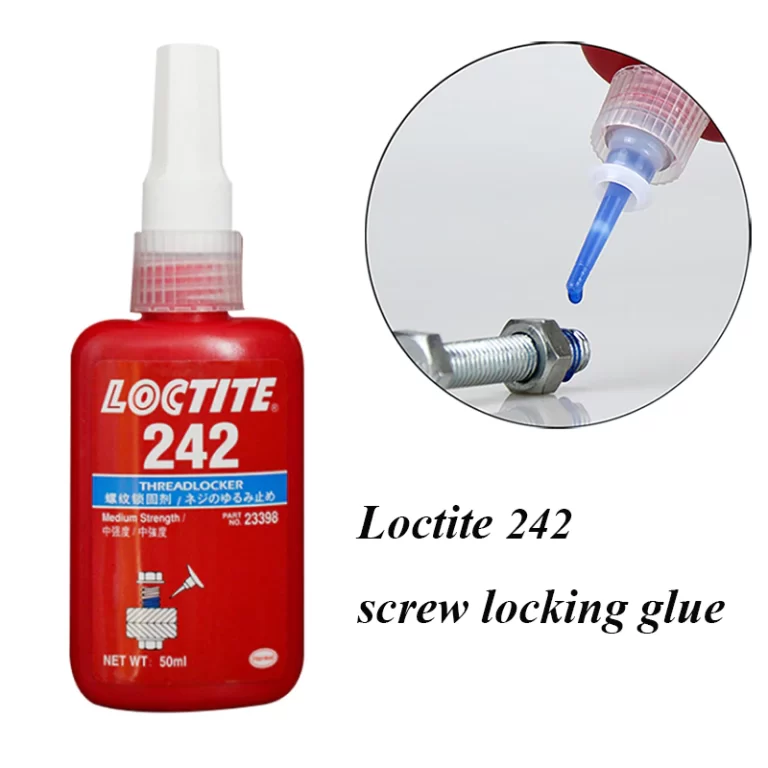Loctite 262 vs 263 vs 271
Loctite 262, 263 and 271 are all high-strength thread locker adhesives produced by Henkel Loctite.
Loctite 262 is a medium-strength thread locker for securing fasteners that require normal disassembly.
Loctite 263 is a high-strength thread locker for heavy-duty applications where high vibration or extreme shock is expected.
Loctite 271 is a high-strength, removable thread locker for applications where disassembly is required for servicing.
Each of these adhesives is formulated for specific application requirements and offers unique advantages. It is important to choose the right adhesive for your specific application to ensure optimal performance and reliability.
Loctite 262 Review
Loctite 262 is a medium-strength thread locker adhesive produced by Henkel Loctite. It is designed for use in applications where fasteners require normal disassembly. This makes it ideal for securing nuts and bolts in applications that may need to be taken apart in the future.
Here are some key specifications and features of Loctite 262:
- Strength: Medium
- Cure Time: 24 hours
- Maximum Operating Temperature: 300°F (149°C)
- Chemical Type: Anaerobic
- Color: Red
Loctite 262 is an anaerobic adhesive, meaning it cures in the absence of air and forms a bond between metal surfaces. This makes it ideal for use in enclosed or tight spaces where air exposure is limited.
Once cured, Loctite 262 provides a secure bond that resists vibration and shock. It is also resistant to various chemicals, including oils and fuels, making it suitable for use in automotive and industrial applications.
In summary, Loctite 262 is a versatile, medium-strength thread locker that provides a secure bond for fasteners that require normal disassembly. Its ability to resist vibration, shock, and chemicals make it ideal for a variety of applications.
Loctite 263 Review
Loctite 263 is a high-strength thread locker adhesive produced by Henkel Loctite. It is designed for use in heavy-duty applications where high vibration or extreme shock is expected. This makes it ideal for securing critical fasteners in demanding industrial and automotive applications.
Here are some key specifications and features of Loctite 263:
- Strength: High
- Cure Time: 24 hours
- Maximum Operating Temperature: 300°F (149°C)
- Chemical Type: Anaerobic
- Color: Green
Like all Loctite thread locker adhesives, Loctite 263 is an anaerobic adhesive that forms a secure bond between metal surfaces. It cures in the absence of air, making it ideal for use in enclosed or tight spaces where air exposure is limited.
Once cured, Loctite 263 provides a strong, permanent bond that resists vibration and extreme shock. It is also resistant to various chemicals, including oils and fuels, making it suitable for use in a wide range of applications.
One of the key advantages of Loctite 263 is its high strength. This makes it ideal for securing critical fasteners in demanding applications where failure is not an option. Additionally, its ability to resist vibration and shock means it can be relied on to maintain its bond even in harsh environments.
In summary, Loctite 263 is a high-strength thread locker that provides a secure, permanent bond for fasteners in demanding applications. Its resistance to vibration, shock, and chemicals make it ideal for use in a variety of industrial and automotive applications.
Loctite 271 Review
Loctite 271 is a high-strength, removable thread locker adhesive produced by Henkel Loctite. It is designed for applications where disassembly is required for servicing. This makes it ideal for securing fasteners that may need to be taken apart in the future, such as in automotive or industrial applications.
Here are some key specifications and features of Loctite 271:
- Strength: High
- Cure Time: 24 hours
- Maximum Operating Temperature: 300°F (149°C)
- Chemical Type: Anaerobic
- Color: Blue
Like all Loctite thread locker adhesives, Loctite 271 is an anaerobic adhesive that forms a secure bond between metal surfaces. It cures in the absence of air, making it ideal for use in enclosed or tight spaces where air exposure is limited.
One of the key advantages of Loctite 271 is its high strength and ability to be removed. This makes it ideal for securing fasteners that may need to be taken apart in the future for servicing or maintenance. The bond can be broken with hand tools or a heat gun, making disassembly quick and easy.
Once cured, Loctite 271 provides a strong, permanent bond that resists vibration and extreme shock. It is also resistant to various chemicals, including oils and fuels, making it suitable for use in a wide range of applications.
In summary, Loctite 271 is a high-strength, removable thread locker that provides a secure, permanent bond for fasteners that may need to be taken apart in the future. Its resistance to vibration, shock, and chemicals make it ideal for use in a variety of industrial and automotive applications.
Differences Between Loctite 262 and 263
Loctite 262 and 263 are both high-strength thread locker adhesives produced by Henkel Loctite. While they share many similarities, there are some key differences between the two products that make them better suited for different applications.
Here are some of the key differences between Loctite 262 and 263:
- Strength: Loctite 263 is a high-strength thread locker, while Loctite 262 is a medium-strength thread locker. This makes Loctite 263 better suited for heavy-duty applications where high vibration or extreme shock is expected, while Loctite 262 is better suited for applications where normal disassembly is required.
- Color: Loctite 263 is green, while Loctite 262 is red. This makes it easier to differentiate between the two products and to know which product is being used in a given application.
- Bond Strength: Loctite 263 forms a stronger bond than Loctite 262, making it better suited for applications where a secure, permanent bond is required.
- Disassembly: While both products are designed for permanent bonds, Loctite 262 can be disassembled with hand tools, while disassembly of Loctite 263 requires the use of heat or specialized tools.
- Vibration Resistance: Loctite 263 is better suited for applications where vibration is a concern, as it provides a more secure bond and is more resistant to vibration than Loctite 262.
In summary, while both Loctite 262 and 263 are high-strength thread locker adhesives, there are differences in strength, color, bond strength, disassembly, and vibration resistance that make each product better suited for specific applications.
Differences Between Loctite 262 vs 271
Loctite 262 and 271 are both thread locker adhesives produced by Henkel Loctite. While they are both designed for securing fasteners, there are some key differences between the two products that make them better suited for different applications.
Here are some of the key differences between Loctite 262 and 271:
- Strength: Loctite 271 is a high-strength thread locker, while Loctite 262 is a medium-strength thread locker. This makes Loctite 271 better suited for heavy-duty applications where high vibration or extreme shock is expected, while Loctite 262 is better suited for applications where normal disassembly is required.
- Color: Loctite 271 is blue, while Loctite 262 is red. This makes it easier to differentiate between the two products and to know which product is being used in a given application.
- Bond Strength: Loctite 271 forms a stronger bond than Loctite 262, making it better suited for applications where a secure, permanent bond is required.
- Disassembly: Loctite 271 is designed to be removable, allowing for disassembly with hand tools or a heat gun. Loctite 262, on the other hand, forms a permanent bond that cannot be easily disassembled.
- Vibration Resistance: Loctite 271 is better suited for applications where vibration is a concern, as it provides a more secure bond and is more resistant to vibration than Loctite 262.
In summary, while both Loctite 262 and 271 are thread locker adhesives, there are differences in strength, color, bond strength, disassembly, and vibration resistance that make each product better suited for specific applications.
Differences Between Loctite 263 vs 271
Loctite 263 and 271 are both high-strength thread locker adhesives produced by Henkel Loctite. While they share many similarities, there are some key differences between the two products that make them better suited for different applications.
Here are some of the key differences between Loctite 263 and 271:
- Strength: Both Loctite 263 and 271 are high-strength thread locker adhesives, but Loctite 271 is designed to be removable, while Loctite 263 forms a permanent bond.
- Color: Loctite 263 is green, while Loctite 271 is blue. This makes it easier to differentiate between the two products and to know which product is being used in a given application.
- Bond Strength: Loctite 263 forms a stronger bond than Loctite 271, making it better suited for applications where a secure, permanent bond is required.
- Disassembly: Loctite 271 is designed to be removable, allowing for disassembly with hand tools or a heat gun. Loctite 263, on the other hand, forms a permanent bond that cannot be easily disassembled.
- Vibration Resistance: Both Loctite 263 and 271 are designed to provide a secure bond and resist vibration, but Loctite 263 is better suited for heavy-duty applications with high vibration or extreme shock.
In summary, while both Loctite 263 and 271 are high-strength thread locker adhesives, there are differences in strength, color, bond strength, disassembly, and vibration resistance that make each product better suited for specific applications.
Final Thoughts
The best choice between Loctite 262, 263, and 271 depends on the specific requirements of the application.
Loctite 262 is a medium-strength thread locker that is well-suited for applications where normal disassembly is required. It forms a permanent bond, but is not as strong as Loctite 263 or 271.
Loctite 263 is a high-strength thread locker that forms a permanent bond. It is well-suited for applications where a secure, permanent bond is required, especially in heavy-duty applications with high vibration or extreme shock.
Loctite 271 is a high-strength thread locker that is designed to be removable. It is well-suited for applications where disassembly is required, and provides a secure bond that is resistant to vibration.
Ultimately, the choice between Loctite 262, 263, and 271 will depend on the specific requirements of the application, including the strength and permanence of the bond required, the need for disassembly, and the level of vibration and shock the application will be exposed to.

